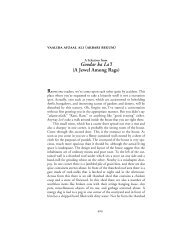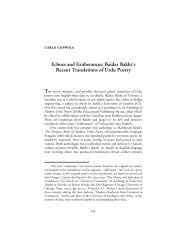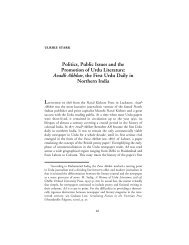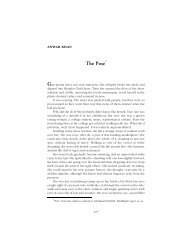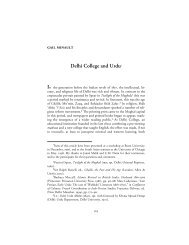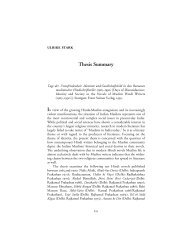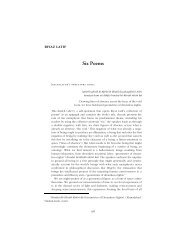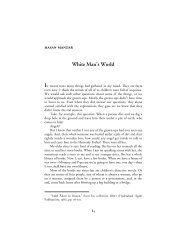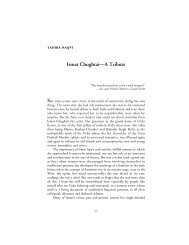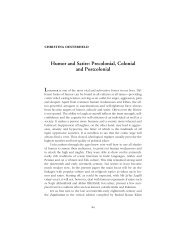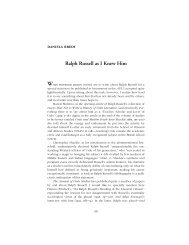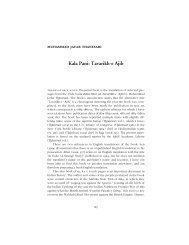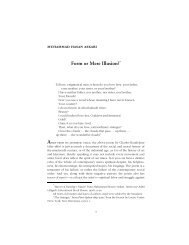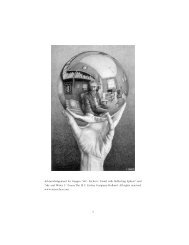Premchand's âShatranj ke Khilariâ in Translation - the Annual of Urdu ...
Premchand's âShatranj ke Khilariâ in Translation - the Annual of Urdu ...
Premchand's âShatranj ke Khilariâ in Translation - the Annual of Urdu ...
You also want an ePaper? Increase the reach of your titles
YUMPU automatically turns print PDFs into web optimized ePapers that Google loves.
204 • The <strong>Annual</strong> <strong>of</strong> <strong>Urdu</strong> Studies, No. 28<br />
cally, orthographicallyóand set about educat<strong>in</strong>g <strong>the</strong> readership it needed<br />
to legitimate its be<strong>in</strong>gî (2010a, 33).<br />
In addition to <strong>the</strong> narratorís commentary, Premchand uses <strong>the</strong> dramatic,<br />
dialogic style to convey a sense <strong>of</strong> <strong>the</strong> lifestyle <strong>of</strong> <strong>the</strong> protagonists.<br />
As <strong>the</strong> H<strong>in</strong>di narrative develops, <strong>the</strong> narrator gradually switches to <strong>the</strong><br />
simpler H<strong>in</strong>dustani, employ<strong>in</strong>g an easy, conversational style and even a<br />
colloquial idiom. Occasionally, he uses <strong>Urdu</strong> vocabulary. Once he has<br />
delivered most <strong>of</strong> <strong>the</strong> <strong>in</strong>troductory statements <strong>in</strong> <strong>the</strong> past tense, he tends<br />
to lapse <strong>in</strong>to a present/present-cont<strong>in</strong>uous tense narrative <strong>in</strong>volv<strong>in</strong>g <strong>the</strong><br />
lifestyle <strong>of</strong> <strong>the</strong> two jāgīrdārs. With its satiric tone and abundant use <strong>of</strong><br />
Sanskritic vocabulary, <strong>the</strong> H<strong>in</strong>di text clearly deprecates <strong>the</strong> cultural ethos<br />
<strong>of</strong> erstwhile Awadh and balances <strong>the</strong> artistic, literary and economic pursuits<br />
<strong>of</strong> <strong>the</strong> people with <strong>the</strong>ir leisurely recreations, which are <strong>in</strong>dicative <strong>of</strong> frivolity.<br />
The narratorís paren<strong>the</strong>tical asides, tongue-<strong>in</strong>-cheek comments and<br />
ironic observations supply <strong>the</strong> sarcasm. For <strong>in</strong>stance:<br />
Shatranj, tāsh, ganjifa kẖelnē sē buddẖī tīrv hōtī hai, vičār-shaktī kā<br />
vikās hōtā hai, peñčīda maslōñ kō suljẖānē kī ādat paṛtī hai. Yeh dalīlēñ<br />
zōrōñ kē sātẖ pēsh kī jātī tẖīñ. (Is sampradāye kē lōgōñ sē duniyā ab bẖī<br />
khālī nahīñ hai.)<br />
(Premchand 2011, 104)<br />
By play<strong>in</strong>g chess, cards or ganjifa <strong>the</strong> wits were sharpened, <strong>the</strong> process<br />
<strong>of</strong> thought was developed, one became accustomed to solv<strong>in</strong>g complex<br />
problemsóarguments <strong>of</strong> this sort were presented with great vehemence.<br />
(The world is not free even today <strong>of</strong> people <strong>of</strong> this persuasion!)<br />
(Premchand 1988, 182)<br />
The <strong>Urdu</strong> narrator conveys a similar sense <strong>of</strong> <strong>the</strong> times but his observations<br />
are less caustic, primarily because <strong>the</strong> paren<strong>the</strong>sis is avoided and<br />
<strong>the</strong> focus is only on <strong>the</strong> game <strong>of</strong> chess:<br />
Fikr kō jaulān ʿaql kō rasā aur ẕehn kō tēz karnē kē liyē sharanj<br />
kīmiyā samjẖā jātā tẖā. Ab bẖī is qaum kē lōg kahīñ-kahīñ maujūd haiñ<br />
jō is dalīl kō baṛē shadd-o-madd se pēsh kartē haiñ.<br />
(Premchand 2010, 83)<br />
Chess was considered <strong>in</strong>strumental <strong>in</strong> stimulat<strong>in</strong>g <strong>the</strong> imag<strong>in</strong>ation, polish<strong>in</strong>g<br />
<strong>the</strong> wit and sharpen<strong>in</strong>g <strong>the</strong> <strong>in</strong>telligence. People belong<strong>in</strong>g to this<br />
community who present such po<strong>in</strong>ts <strong>of</strong> view with great vehemence are still<br />
to be found, here and <strong>the</strong>re. 4<br />
Also noteworthy is <strong>the</strong> narratorís po<strong>in</strong>t<strong>in</strong>g out, later <strong>in</strong> <strong>the</strong> story, that<br />
4 Unless o<strong>the</strong>rwise <strong>in</strong>dicated, all translations are m<strong>in</strong>e.



